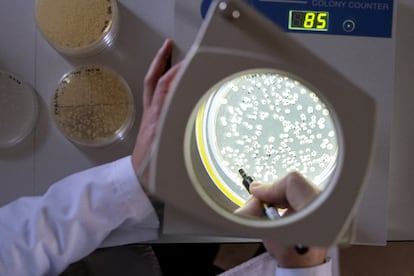The keys to longevity are hidden in the microbes that give us beer and wine
An experiment has managed to increase the lifespan of a species of yeast by 80% through the use of synthetic biology techniques

More than three decades ago, Thomas Johnson demonstrated that modifying a single gene – called age-1 – increased the lifespan of C. elegans worms by up to 60%. Despite the enormous evolutionary distance that separates us from these creatures, useful mechanisms for survival jump from branch to branch of the tree of life – they’re conserved in the genomes of many species, including humans. What works on a worm or a mouse – or even on a species of yeast – need not work on us as well. But the results stemming from manipulating the life expectancy of these remote relatives encourages the search for genetic modifications.
Three years ago, a group of researchers from the University of California at San Diego (UCSD) found an essential mechanism in the aging process of a unicellular fungus that has been with us since the beginning of civilization. The species of yeast called Saccharomyces cerevisiae – with which bread, beer and wine is made – follows one of two directions on its way to death. Half of its cells age when their DNA loses stability; the other half, with the deterioration of the mitochondria, a structure that provides energy to the cell.
The same UCSD researchers – led by Nan Hao – have now published an article in the academic journal Science. They explain how they have created a kind of switch that – by manipulating two regulators of gene activity – reverses cell aging. From DNA to mitochondria decay, a brewer uses a mechanism to keep yeast cells in balance. In a way similar to that of a thermostat – where when a higher temperature is reached the refrigerator amps up and when a lower temperature is reached, a heating system kicks in – synthetic biology is being applied to introduce a similar system. With what is known as a genetic oscillator, cells change the way they age when they have gone too far in one of two directions. With this game of balances, the scientists have prolonged the existence of the yeast by up to 80% – a new world record in biology. The researchers suggest that this type of oscillator could also serve to slow down the path to death that begins every time a cell appears within the human body.
The authors intend to “identify the regulatory genetic circuits [beneath] aging in various types of human cells and apply this engineering strategy to modify them and slow down their aging,” explains Nan Hao, lead author of the study and co-director of the Institute of Synthetic Biology at UCSD. “If it works, we’ll try to do the same thing in cells inside living animals, like mice,” he adds.
Hao acknowledges that genetic engineering “requires more time in human cells and the circuits that regulate genes are often more complicated. We’ll need more time and resources to test these ideas and strategies, but I don’t think there’s anything fundamental that prevents us from doing it,” he concludes.
Carlos López Otín – a researcher at the University of Oviedo (Spain) and an expert in aging – recognizes the value of the study by these researchers who, like others before them, have used “simple models to try to understand the colossal and fascinating complexity of life.”
“It may seem strange that, from a single-celled organism, we can learn lessons about the effect of time on our bodies made up of many trillions of cells. But we shouldn’t forget a legendary line from the great Jacques Monod (Nobel Laureate in Medicine) for discovering the first keys to gene regulation in bacteria: ‘What is valid for a bacterium is also valid for an elephant.’ [That being said], its extrapolation to human cells and our daily lives still seems far away.”
This could contribute to improving our health… something that seems to be a more sensible and affordable goal than aspiring to improbable dreams of immortalityCarlos López Otín, University of Oviedo
“Unicellular organisms [like the yeast used in this experiment] are naturally selfish: their main objective is to divide. The dream of a bacterium or a yeast is to create others just like them,” López Otín explains. This “cellular selfishness is a purpose that our altruistic and supportive cells reject” and only adopt it if – by accumulating molecular damage – they transform and become tumorous.
“For this reason, in humans, it’s not enough to prevent cells from aging at all costs and to extend longevity. The price of these strategies – so publicized and longed for by some – can be the development of serious pathologies, including malignant tumors, capable of reducing human longevity considerably,” López Otín cautions.
For the scientist, the question that arises from these results is: if evolution could have created an oscillator similar to the one created by these authors by modifying only two genes, why hasn’t this happened since the appearance of life more than 3.5 billion years ago?
In order to understand the reason for this gap – while also understanding the costs of extending longevity – López Otín proposes carrying out an experiment in which yeasts carrying the modified genes are allowed to compete with the corresponding normal yeasts “to analyze if any of the [modified] strains [influence the untouched ones] over time under different conditions.” In addition, he proposes creating other types of oscillators, not to unnecessarily extend longevity, but in an effort to maintain homeostasis – our essential internal balance. “This could contribute to improving our health… something that seems to be a more sensible and affordable goal than aspiring to improbable dreams of immortality,” he concludes.
For Jordi García Ojalvo – a researcher at the Universitat Pompeu Fabra in Barcelona and a collaborator of Michael Elowitz, creator of the first synthetic genetic oscillator – he believes that “beyond the applications that the results of this study may have [many years from now], the interesting thing is that it shows how synthetic biology can be used to understand how organisms work and how they age. It helps us push the limits of that knowledge.”
“Aging in human cells or in a whole organism is very complicated. But all cells on Earth have 20 amino acids and the same four nucleic acids,” he adds. “What we learn from these cells may be useful to search for applications.”
Sign up for our weekly newsletter to get more English-language news coverage from EL PAÍS USA Edition
Tu suscripción se está usando en otro dispositivo
¿Quieres añadir otro usuario a tu suscripción?
Si continúas leyendo en este dispositivo, no se podrá leer en el otro.
FlechaTu suscripción se está usando en otro dispositivo y solo puedes acceder a EL PAÍS desde un dispositivo a la vez.
Si quieres compartir tu cuenta, cambia tu suscripción a la modalidad Premium, así podrás añadir otro usuario. Cada uno accederá con su propia cuenta de email, lo que os permitirá personalizar vuestra experiencia en EL PAÍS.
¿Tienes una suscripción de empresa? Accede aquí para contratar más cuentas.
En el caso de no saber quién está usando tu cuenta, te recomendamos cambiar tu contraseña aquí.
Si decides continuar compartiendo tu cuenta, este mensaje se mostrará en tu dispositivo y en el de la otra persona que está usando tu cuenta de forma indefinida, afectando a tu experiencia de lectura. Puedes consultar aquí los términos y condiciones de la suscripción digital.
More information
Últimas noticias
From Christmas movies to carols: Trump administration uses the holidays to push its anti-immigrant agenda
Trump’s worldview clashes with a Europe trying to defend itself
The program that guarantees Denver migrants will end up on the ‘Success Wall’
Venezuelan oil, the ultimate prize coveted by the United States
Most viewed
- Christian Louboutin: ‘Young people don’t want to be like their parents. And if their parents wear sneakers, they’re going to look for something else’
- ‘El Limones’ and the growing union disguise of Mexican organized crime
- The low-cost creative revolution: How technology is making art accessible to everyone
- ‘We are dying’: Cuba sinks into a health crisis amid medicine shortages and misdiagnosis
- Cartels in Mexico take a leap forward with narco-drones: ‘It is criminal groups that are leading the innovation race’










































